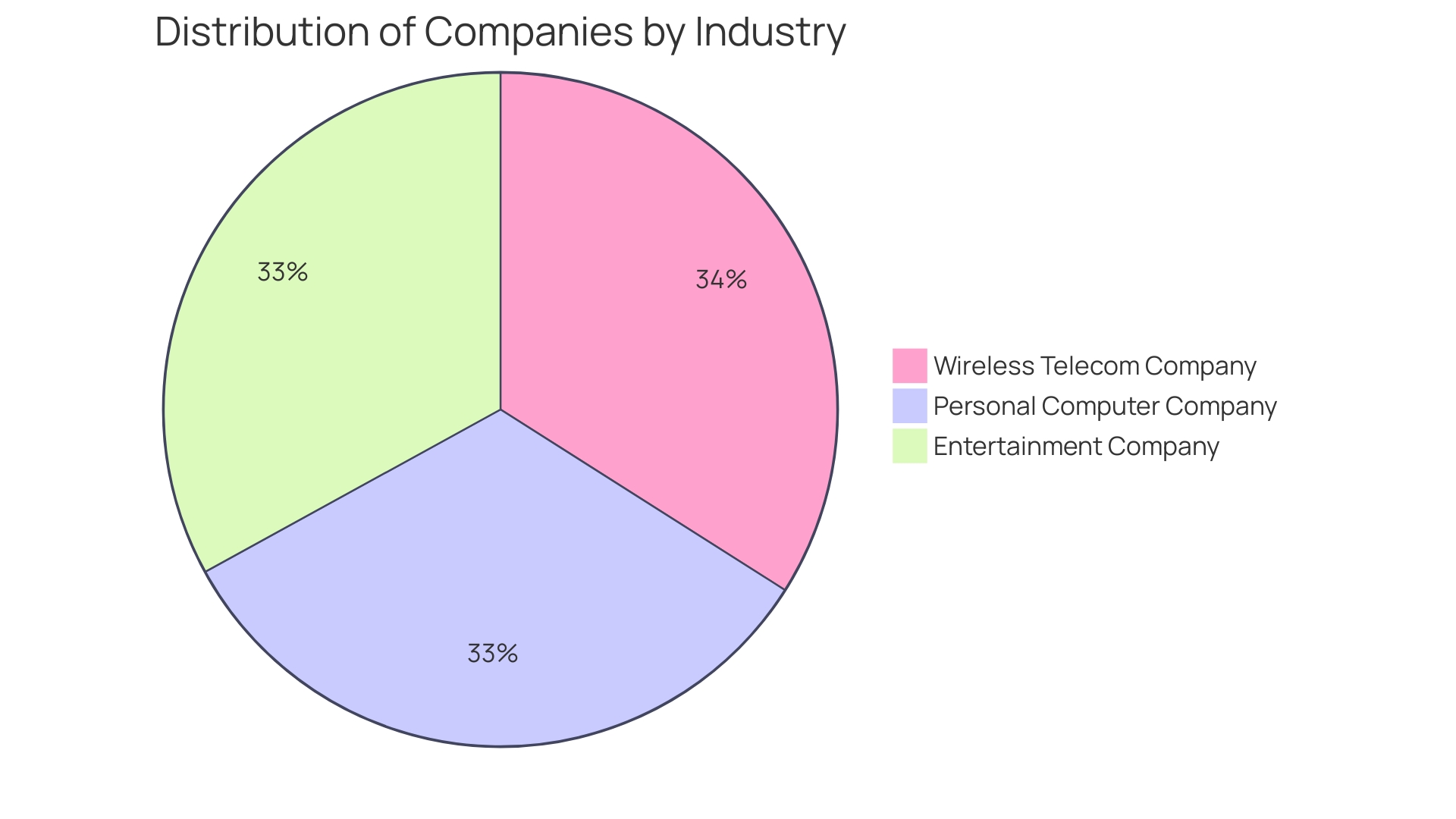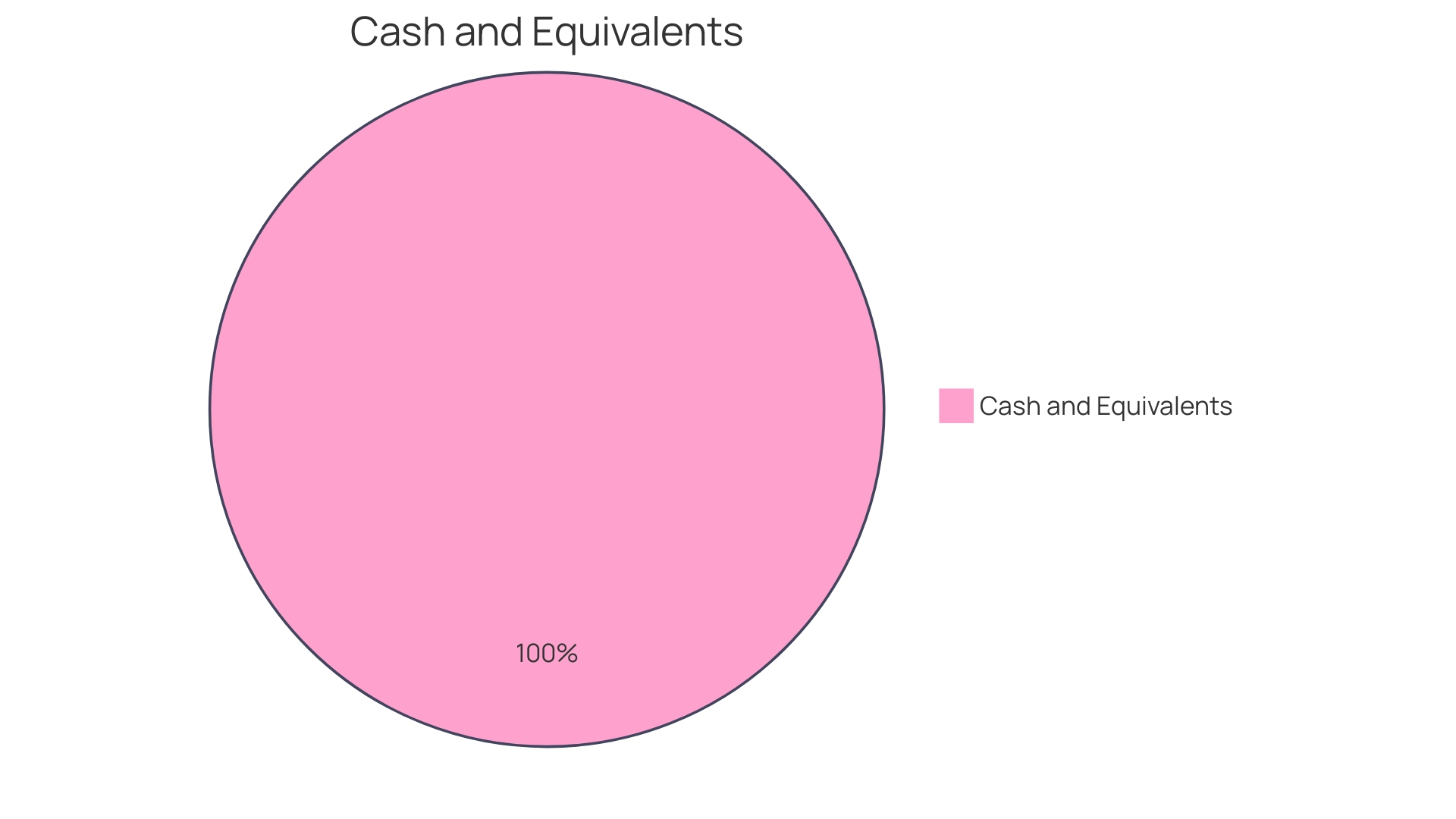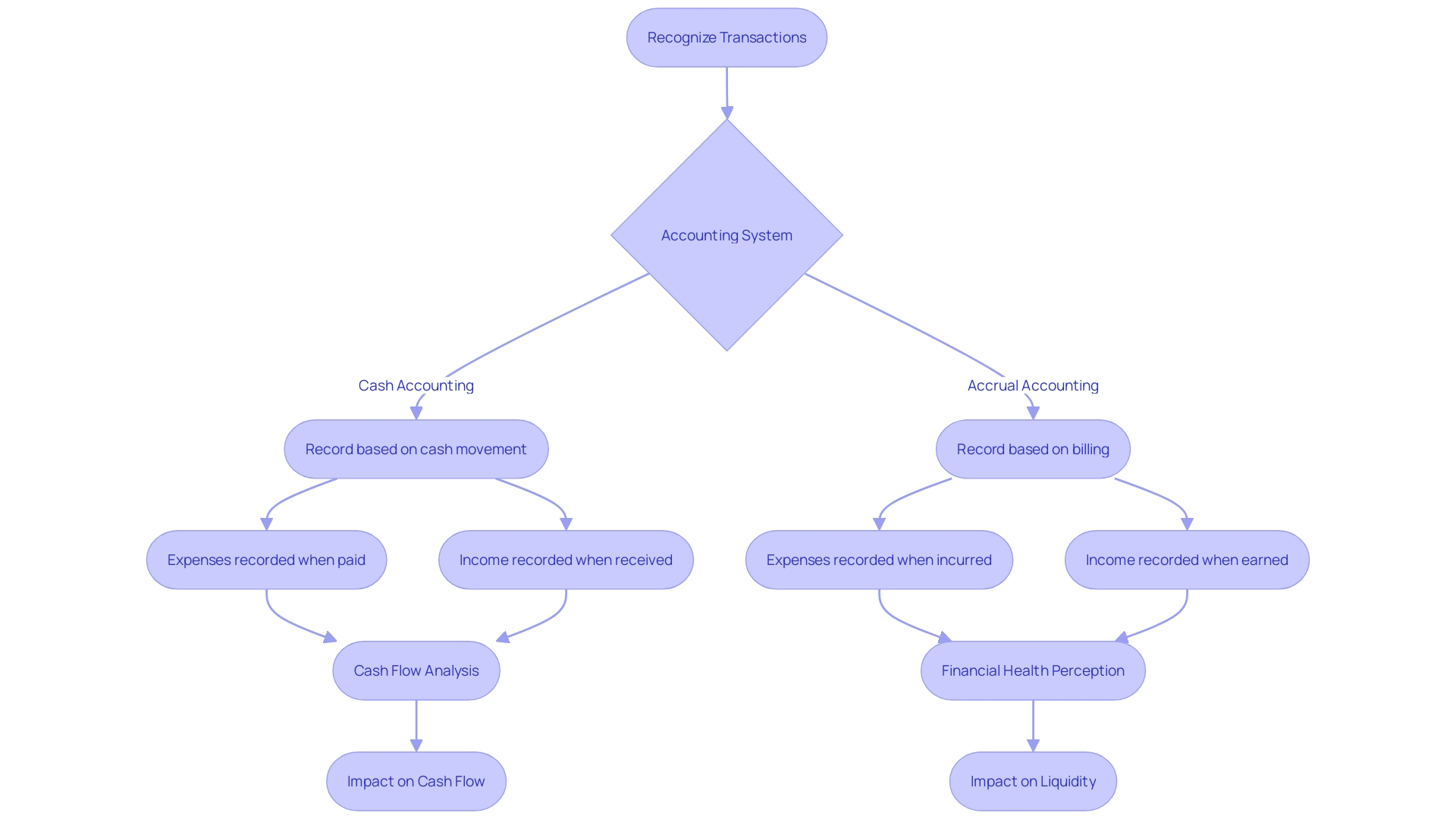Introduction
Understanding cash flows from financing activities is vital in the realm of cost accounting, as it provides insight into how a company funds its operations and growth. These cash flows encompass transactions between a company and its financiers, such as equity and debt. Creating stable cash flows that are not solely reliant on market upswings is crucial for long-term success.
This article explores the various forms of raising capital or repaying investors, the significance of cash flow management, and the impact of financing activities on a company's overall cash flow. By leveraging quantitative examples and industry cases, CFOs can better navigate the complexities of cash flows and ensure their organizations remain solvent and competitive.
What are Cash Flows from Financing Activities?
Understanding cash flows from financing activities is pivotal in the realm of cost accounting, as it paints a picture of how a company funds its operations and growth. These cash flows are the monetary transactions between a company and its financiers, including equity and debt. For instance, when a market maker like Flow Traders engages in financial transactions, they rely on the delicate balance between bid and ask prices to manage risks and ensure profitability, irrespective of market conditions.
Their approach highlights the importance of creating stable cash flows that do not rely on market upswings alone.
In the broader context, these activities encompass various forms of raising capital or repaying investors, such as issuing shares or bonds and paying dividends or loans. A clear example of the significance of cash flow management can be seen in the actions taken by the Royal Bank of Canada (RBC). After an investigation by the OSC, which found no evidence of dishonest conduct, RBC took corrective actions to prevent future occurrences of similar events, underscoring the ongoing need for rigorous financial reporting and management.
Moreover, a sound grasp of cash flows provides insight into a company's ability to generate future economic benefits. This is crucial information for investors, as highlighted by financial experts, who assert that the difference between cash flow and profit is a cornerstone of financial performance. Cash flow signifies the lifeblood of a business, enabling it to thrive or signaling potential distress.
Dr. Sharon H. Porter emphasizes the importance of thorough financial statement reviews, including cash flow statements, to avoid critical mistakes in cash flow management.
Free Cash Flow (FCF) is a key metric derived from these cash flows, representing the net cash available after accounting for Capital Expenditures (CAPEX). To illustrate, if company Jeans X has an Operating Cash Flow and deduces its CAPEX, the remainder is its FCF, which investors closely monitor for growth potential. It's essential for businesses to maintain robust FCFs to signal financial health and attract investment.
In essence, the tapestry of financing activities is complex and multifaceted, with an organization's financial stability hanging on the ability to manage these flows effectively. By leveraging quantitative examples and industry cases, CFOs can better navigate the intricacies of cash flows, ensuring their organizations remain solvent and competitive.

Sources of Cash from Financing Activities
Financing activities are a fundamental aspect of a company's cash flow, shedding light on the inflow of cash that can bolster financial stability and facilitate growth. Among the prevalent methods of securing such funds, issuing stocks remains a popular choice, enabling companies to raise capital without incurring debt. Conversely, issuing bonds is another avenue, offering a fixed-income investment to the contributors and a steady stream of capital for the organization.
Companies may also opt for loans, which, while increasing debt, provide immediate liquidity to finance operations or investments. Additionally, other external financing mechanisms, such as NAV finance, offer non-dilutive capital based on the net asset value of investment portfolios, particularly for private equity funds. This form of financing has gained traction, supporting liquidity and portfolio management.
Securities lending also contributes to a company's financing options. This involves lending stocks or bonds to brokers or hedge funds against a fee, and it's a strategy that can modestly boost fund returns. It requires collateral, typically cash in the U.S., to mitigate risk for the lending fund.
Furthermore, regulatory developments can influence financing opportunities. For instance, China's NDRC initiative to allow certain high-performing companies to borrow medium to long-term foreign debt underlines the evolving landscape where compliance and strategic alignment with national policies can unlock financing possibilities.
In the capital markets, however, shifts such as job restructuring at firms like Industrial Alliance signal changes that could impact the availability and approach to capital sourcing. All these elements play a significant role in shaping the options and strategies for CFOs when considering cash inflows from financing activities.

Uses of Cash from Financing Activities
Understanding the flow of cash from financing activities offers a lens into the strategic choices a company makes. This includes decisions to manage debt, return capital to shareholders, or reinvest in the organization. For example, when a company like Monday.com optimizes its operations to become free cash flow positive, it reflects a strategic pivot towards efficiency and potentially signals a shift in capital allocation priorities.
Securities lending is another avenue through which companies can augment their cash position. In essence, a company can lend out stocks or bonds from its portfolio to earn additional income. This practice is beneficial as it can offset management fees and boost overall returns.
The cash or securities received as collateral further enhance the liquidity position of the company, allowing for more strategic flexibility.
The broader financial landscape also plays a crucial role in shaping a company's financing activities. The Federal Reserve's report indicates households in the U.S. hold substantial amounts in liquid assets. This abundance of liquid assets can affect the market and influence a company's financing decisions.
For instance, in a market flush with cash, a company might find it advantageous to issue debt at favorable rates to fund growth initiatives or buy back stock.
As Adam Smith observed, the value of assets is intrinsically tied to their future cash flows and the prevailing interest rates. This understanding is crucial when considering the impact of financing activities on a company's value. In an era marked by fluctuating interest rates and economic uncertainty, CFOs must be acutely aware of how these macroeconomic factors can affect the cost of capital and, consequently, the strategic financial decisions they make.
In summary, cash from financing activities can serve multiple purposes, from debt repayment to shareholder dividends. The ultimate use of this cash reflects a company's strategic financial vision, balancing growth with shareholder value, and the efficient deployment of resources to strengthen its market position.
Examples of Financing Activities
Let's delve into the practical side of finance and examine how certain transactions can influence a company's cash flow. Consider stock issuances: when a company issues new shares, it receives fresh capital that boosts its cash reserves. Conversely, when it comes to bond repayments, the company's cash outflow increases as it settles debts, impacting liquidity.
Take loan acquisitions; these can provide immediate cash inflow, crucial for operational needs or strategic investments. It's a delicate balance, however, as the long-term cost of taking on new debt must be weighed against the immediate financial benefits.
For instance, a company like IBM, known for its prudent financial management, managed to surpass Wall Street's revenue expectations and consequently raised its full-year free cash flow forecast to over $12 billion. This demonstrates the importance of effective cash flow management and its impact on a company's financial health and ability to fund shareholder-friendly initiatives.
Moreover, NAV finance is an intriguing concept that employs the net asset value of investment portfolios to provide non-dilutive capital, enabling funds to enhance liquidity and create value. This form of finance has gained traction as it allows funds to manage portfolios more effectively without diluting existing shareholders' stakes.
Understanding these financial maneuvers requires a clear grasp of cash flow concepts. Free cash flow, for example, is a metric that subtracts capital expenditures (CAPEX) from operating cash flow, revealing how much money remains after covering all costs. It's essential for businesses to track this to ensure they can sustain operations and pursue growth opportunities.
In conclusion, each financial activity, from issuing stocks to managing loans, plays a critical role in shaping a company's cash flow. By analyzing real-world examples, CFOs can gain insights into the strategic application of these activities to maintain a healthy cash flow balance, crucial for long-term business success.
How to Identify and Calculate Cash Flows from Financing
Understanding the cash flows from financing activities is a critical element for any business's financial health. This process involves a meticulous examination of specific line items in a company's financial statements. By analyzing these entries, organizations can discern the integrity of financial reporting, revealing the true picture of where money is coming from and its impact on shareholder value.
For instance, case studies like that of Monday.com illustrate the significance of free cash flow in evaluating a company's efficiency and growth prospects. The software company quickly became free cash flow positive as growth decelerated, demonstrating the company's ability to optimize shareholder value by efficiently managing its cash runway.
Moreover, the statement of cash flows, as per the insights shared by the SEC, is a vital financial statement that requires rigorous attention and auditing. It's a document that divides cash flow into operating, investing, and financing activities, aiding investors in assessing a company’s ability to generate future cash flows, meet obligations, and return cash to shareholders.
The lessons from Monday.com and the SEC's emphasis on the quality of cash flow reporting underscore the importance of a thorough understanding of financing activities. This understanding can be further enhanced by keeping abreast of recent IRS clarifications on software development costs, which can affect a company's capital expenditures and subsequently its free cash flow.
Lastly, knowledge of profit and loss statements, as described in the hospitality industry context, shows how intricately related income and expenses are to overall cash flow, reinforcing the need for CFOs to maintain a clear view of financial activities. This clarity helps in making informed decisions that align with the company's long-term financial goals without compromising on the day-to-day operational needs.
Interpreting Cash Flows from Financing Activities
Understanding the nuances of cash flows from financing activities is pivotal for assessing the financial well-being of a company. The ability to analyze and interpret these flows allows for a deeper evaluation of a company's capital structure, and it supports more strategic financial decision-making. Key metrics and ratios gleaned from this analysis can be invaluable tools.
For instance, Monday.com's growth trajectory and its fast achievement of positive free cash flow when growth moderated is a testament to the efficiency of their operational model. It highlights the significance of gross margins and the direct impact on shareholder value. Similarly, understanding the relationship between costs and revenue through comprehensive analysis of Profit & Loss statements, as done in the hotel industry, enhances the ability to strategize effectively.
Moreover, with privacy concerns on the rise, the transparency and precision of cash flow statements are more crucial than ever. Investors rely on these statements to gauge the potential for future cash generation, meeting obligations, and the return of cash to shareholders.
To put it into perspective, cash flow can be broken down into operating cash flow, which reflects the cash generated by a company's normal business operations, and capital expenditures (CAPEX), which are the investments made in maintaining or improving the company's assets. The difference between these two is the free cash flow, a metric representing the cash a company has available after maintaining or expanding its asset base. For example, if Jeans X has an operating cash flow of $100 million and CAPEX of $20 million, its free cash flow would be $80 million.
In summary, CFOs should not only focus on the top line of cash flow statements but delve into the bottom line for actionable insights, thereby enabling more efficient growth and operational success.

Impact of Financing Activities on Overall Cash Flow
Understanding the dynamics of cash flow is akin to mastering the lifeblood of a business. It's essential to comprehend how financing activities are intertwined with operating and investing activities, as these interactions ultimately shape the net change in cash over a given period. For instance, Monday.com exemplifies a scenario where efficient growth strategies enabled the company to become free cash flow positive, even as growth decelerated.
Such efficiency leads to more available cash for reinvestment, extended cash runways, and enhanced shareholder value, which are critical components of financial health and agility.
The concept of cash flow management encompasses not only the monitoring of cash inflows and outflows within a business but also devising strategies to uphold a robust balance. This is crucial, as a shortfall in cash can be catastrophic, potentially leading to the downfall of even the most promising enterprises. To illustrate, consider the operating cash flow equation: Operating Cash Flow = Revenue - CAPEX (Capital Expenditures).
A company's operating cash flow reflects the cash generated by its core business operations after accounting for capital expenditures.
For instance, let's examine a hypothetical company, Jeans X. By understanding its operating cash flow and capital expenditures, one can calculate its free cash flow, which is a pivotal metric indicating the company's ability to generate cash after covering all costs. A growing free cash flow is a strong indicator of a company's financial health and its potential to create shareholder value.
Moreover, the distinction between cash flow and profit must be clear, as these are two distinct financial measures critical to a business's survival and prosperity. While cash flow denotes the movement of cash into and out of a business, profit is the residual amount after all expenses have been deducted from revenue. A business must maintain a steady cash flow to avoid disruptions and ensure sustained operations.
The financial landscape constantly presents challenges and opportunities, as evidenced by the diverse array of companies from various sectors, such as MBIA Inc., that engage in public finance and structured finance activities. These companies navigate complex financial environments to finance large-scale infrastructure projects, highlighting the importance of robust cash flow management to support long-term growth and stability.
In summary, a comprehensive understanding of how cash flows from financing, operating, and investing activities contribute to the net change in cash is imperative. By mastering this interplay, businesses can safeguard their liquidity, ensuring financial stability and paving the way for future prosperity.
Common Mistakes in Analyzing Financing Cash Flows
Delving into the intricacies of financing cash flows requires a meticulous application of cost accounting principles. Avoid common missteps in this area to ensure accurate interpretations that lead to sound financial decisions. One such mistake is not recognizing the fundamental differences between cash and accrual accounting systems.
Cash accounting records transactions only when cash changes hands, while accrual accounting logs expenses and income when they are billed, regardless of cash movement. This distinction is critical when analyzing cash flows, as it affects the timing and reporting of financial events.
Misunderstanding the unique aspects of cash basis accounting can lead to skewed cash flow analysis. For instance, consider a grocery store purchasing mangos on credit. Cash accounting would delay recognizing the expense until payment, whereas accrual accounting would reflect it when the order is billed.
This variance can significantly impact the perception of a company's financial health and liquidity.
Moreover, financial statement oversight is another area prone to error. A comprehensive review of the cash flow statement, alongside the income statement and balance sheet, is essential. These documents collectively provide insights into revenue, expenses, profitability, and debt, offering a complete picture of a company's performance.
Maintaining a grasp on both cash flow and profit is indispensable for business prosperity. Cash flow, the lifeblood of business, is about the movement of money in and out, and ensuring its steady flow is vital. Conversely, profit is an indicator of financial gain and should not be confused with cash on hand.
Both metrics are pivotal, but they serve different purposes in the financial ecosystem.
Lastly, the quality of cash flow reporting cannot be overstated. It gives investors a window into a company's ability to generate future net cash flows, fulfill financial obligations, and potentially return cash to shareholders. With cash flow statements frequently subjected to restatements and material weaknesses in internal controls, it is paramount that they are prepared with the same diligence as other financial statements.
This attention to detail supports the evaluation of an issuer's financial position and the scrutiny of earnings quality, underpinning high-quality financial reporting for investors.

Best Practices for Managing Cash Flows from Financing
To sustain a robust financial stance, astute cash flow management from financing activities is vital. Shedding light on this, let’s explore actionable measures for CFOs to enhance their cash flow tactics. Delving into methods to curtail financing costs is paramount.
A strategic approach could involve reevaluating all expenditures and prioritizing, as suggested by industry experts. This ensures that funds are channeled effectively, aligning with future organizational goals.
Improving debt structure is another lever to pull. It entails a deep dive into the business’s debt obligations and restructuring them to achieve a balance between short-term and long-term liabilities, thereby securing a more favorable cash flow position. A poignant example of this is the need for cyclical industries to meticulously plan for economic downturns by maintaining adequate cash reserves, highlighting the importance of a resilient debt strategy.
Optimizing dividend policies can also serve as a key strategy. It's a delicate balancing act between rewarding shareholders and retaining sufficient funds for reinvestment and operational liquidity. As Jack McCullough, president of the CFO Leadership Council, states, cash flow is the steady movement that keeps a business thriving, and managing it effectively is crucial to prevent the risks associated with cash shortages.
Moreover, maximizing the use of cash inflows from financing activities is critical. This involves identifying opportunities to deploy financing cash flows strategically, ensuring that they contribute to the company's growth and stability. For instance, when considering capital expenditures (CAPEX), it’s essential to understand the operating cash flow and how it affects the company's free cash flow.
This knowledge is foundational for making informed investment decisions that will foster long-term profitability.
By integrating these strategies, CFOs can steer their organizations towards a more prosperous financial future, ensuring that the lifeblood of the business—its cash—flows unimpededly, driving growth and success.
Conclusion
Understanding cash flows from financing activities is crucial for CFOs in managing the financial health and growth of a company. By leveraging quantitative examples and industry cases, CFOs can navigate the complexities of cash flows, ensuring their organizations remain solvent and competitive. Creating stable cash flows that are not solely reliant on market upswings is essential for long-term success.
A sound grasp of cash flows provides insight into a company's ability to generate future economic benefits. CFOs should review financial statements, including cash flow statements, to avoid critical mistakes in cash flow management. Free Cash Flow (FCF), derived from cash flows, represents the net cash available after accounting for Capital Expenditures (CAPEX), signaling financial health and attracting investment.
Financing activities offer various sources of cash, such as issuing stocks, bonds, or loans. CFOs should stay informed about regulatory developments that influence financing opportunities. Understanding the flow of cash from financing activities offers insights into strategic choices, like managing debt, returning capital to shareholders, or reinvesting in the organization.
Analyzing and interpreting cash flows from financing activities is vital for assessing a company's financial well-being and making strategic decisions. CFOs should recognize differences between cash and accrual accounting systems. Thorough financial statement oversight, including cash flow statements, income statements, and balance sheets, provides a complete picture of performance.
To manage cash flows effectively, CFOs can curb financing costs, improve debt structure, optimize dividend policies, and maximize cash inflows. By implementing these best practices, CFOs steer their organizations towards a prosperous financial future, ensuring uninterrupted cash flow for growth and success.




